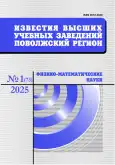Investigation of the electronic and optical properties of thin-film coatings based on SnO₂:Sb
- Authors: Zinchenko T.O.1, Pecherskaya E.A.1, Krevchik V.D.1, Konovalov S.V.2,3, Artamonov D.V.1, Gurin S.A.1, Novichkov M.D.1, Makievski A.4
-
Affiliations:
- Penza State University
- Siberian State Industrial University
- SPL “Polet” of the sub-department of information and measuring technology and metrology Penza State University
- SINTERFACE Technologies
- Issue: No 1 (2025)
- Pages: 81-92
- Section: PHYSICS
- URL: https://bakhtiniada.ru/2072-3040/article/view/297182
- DOI: https://doi.org/10.21685/2072-3040-2025-1-7
- ID: 297182
Cite item
Full Text
Abstract
Background. Transparent conducting oxides (TCOs) based on tin dioxide (SnO₂) doped with antimony (Sb) are of significant interest for modern technologies due to their unique combination of high transparency in the visible range and good electrical conductivity. Such materials are widely used in optoelectronics, solar cells, and sensor devices. However, optimizing their properties requires a deep understanding of charge transport mechanisms, which can be achieved using the classical Drude theory. The purpose of this work is to apply the Drude theory to analyze the electronic and optical properties of SnO₂:Sb thin films obtained by spray pyrolysis, as well as to investigate the influence of charge carrier concentration and mobility on conductivity and plasma frequency. Materials and methods. Thin films of SnO₂:Sb were deposited on glass substrates using the spray pyrolysis method. The charge carrier concentration n was determined using the Hall effect, and the resistivity was measured using the four-point probe method. The classical Drude theory was used to analyze the electronic properties, allowing the calculation of carrier mobility, relaxation time, and plasma frequency. Optical properties were investigated using spectroscopy in the visible and near-infrared ranges. Results. The conductivity σ of SnO₂:Sb films varied in the range of 10³–10⁴ S/m depending on the antimony doping level. The carrier mobility ranged from 4.83∙10⁻⁴ to 15.91∙10⁻⁴ m²/(V·s). The plasma frequency was in the range of 1.19∙10¹⁴ to 7.94∙10¹⁴ rad/s, corresponding to wavelengths from 378 nm to 2520 nm. The SnO₂:Sb films demonstrated high transparency in the visible range (over 80%) for samples with low carrier concentration. With increasing carrier concentration, a shift in the plasma frequency toward the ultraviolet region was observed, leading to a decrease in transparency in the visible range. The drift velocity increased linearly with applied voltage and decreased with increasing distance between contacts. For samples with high mobility, the drift velocity reached values of 13.25∙10⁻⁴ m/s at U =5 mV and d =5 mm. Conclusions. The Drude theorywas successfully applied to analyze the electronic and optical properties of SnO₂:Sb thin films. It was established that the conductivity and transparency of the material can be optimized by varying the antimony doping level. It was shown that the drift velocity of charge carriers depends on mobility, voltage, and sample geometry. This opens up opportunities for designing devices with improved characteristics. The obtained results demonstrate the potential of using SnO₂:Sb in optoelectronic devices where a combination of high transparency and conductivity is required.
About the authors
Timur O. Zinchenko
Penza State University
Author for correspondence.
Email: scar0243@gmail.com
Candidate of engineering sciences, senior lecturer of the sub department of information and measuring technology and metrology
(40 Krasnaya street, Penza, Russia)Ekaterina A. Pecherskaya
Penza State University
Email: pea1@list.ru
Doctor of engineering sciences, professor, head of the sub-department of information and measuring technology and metrology
(40 Krasnaya street, Penza, Russia)Vladimir D. Krevchik
Penza State University
Email: physics@pnzgu.ru
Doctor of physical and mathematical sciences, professor, head of the sub-department of physics, dean of the faculty of information technology and electronics
(40 Krasnaya street, Penza, Russia)Sergey V. Konovalov
Siberian State Industrial University; SPL “Polet” of the sub-department of information and measuring technology and metrology Penza State University
Email: konovalov@sibsiu.ru
Doctor of engineering sciences, professor, vice rector for research and innovation; leading researcher
(42 Kirova street, Novokuznetsk, Kemero region – Kuzbass, Russia);(40 Krasnaya street, Penza, Russia)Dmitry V. Artamonov
Penza State University
Email: dva@pnzgu.ru
Doctor of engineering sciences, professor, professor of the sub department of autonomous information and control systems, first vice-rector
Sergey A. Gurin
Penza State University
Email: teslananoel@rambler.ru
Candidate of engineering sciences, senior researcher at SPL “Polet” of the sub-department of information and measuring technology and metrology
(40 Krasnaya street, Penza, Russia)Maksim D. Novichkov
Penza State University
Email: novichkov1998maks@gmail.com
Postgraduate student, junior research assistant at SPL “Polet” of the sub-department of information and measuring technology and metrology
Alexander Makievski
SINTERFACE Technologies
Email: a.makievski@sinterface.com
Candidate of siences, scientific director of company
(70 Mueggelseedamm, 12587 Berlin, Germany)References
- Drude P. Zur Elektronentheorie der Metalle. Annalen der Physik. 1900;306(3):566–613. doi: 10.1002/andp.19003060312
- Ashcroft N.W., Mermin N.D. Solid State Physics. Philadelphia: Saunders College, 1976:848.
- Pecherskayaa E.A., Zinchenko T.O., Golubkova P.E., Karpanina O.V., Gurina S.A., Novichkov M.D. Analysis of the Influence of Technological Parameters on the Properties of Transparent Conductive Oxides. Theoretical Foundations of Chemical Engineering. 2024;58(3):798–806.
- Pecherskaya E.A., Semenov A.D., Zinchenko T.O., Gurin S.A., Konovalov S.V., Novichkov M.D., Shepeleva A.E., Tuzova D.E. Calculation of the spray supply system characteristics for obtaining film material by spray-pyrolysis. Vacuum. 2025;234:114100. doi: 10.1016/j.vacuum.2025.114100
- Gordon R.G. Criteria for Choosing Transparent Conductors. MRS Bulletin. 2000;25(8):52–57. doi: 10.1557/mrs2000.151
- Ginley D.S., Bright C. Transparent Conducting Oxides. MRS Bulletin. 2000;25(8):15– 18. doi: 10.1557/mrs2000.256
- Chopra K.L., Major S., Pandya D.K. Transparent conductors ‒ A status review. Thin Solid Films. 1983;102(1):1–46. doi: 10.1016/0040-6090(83)90256-0
- Van der Pauw L.J. A method of measuring specific resistivity and Hall effect of discs of arbitrary shape. Philips Research Reports. 1958;13:1–9.
- Mishra R.L., Sharma S., Suresh R. Antimony doped tin oxide thin films: Electrical and optical properties. Materials Science in Semiconductor Processing. 2019;93:33–43. doi: 10.1016/j.mssp.2019.01.005
- Granqvist C.G. Transparent conductors as solar energy materials: A panoramic review. Solar Energy Materials and Solar Cells. 2007;91(17):1529–1598. doi: 10.1016/j.solmat.2007.04.031
- Das S., Jayaraman V. SnO2: A comprehensive review on structures and gas sensors. Progress in Materials Science. 2014;66:112–255. doi: 10.1016/j.pmatsci.2014.06.003
- Ginley D.S., Hosono H., Paine D.C. Handbook of Transparent Conductors. New York: Springer, 2010:533. doi: 10.1007/978-1-4419-1638-9
Supplementary files


























